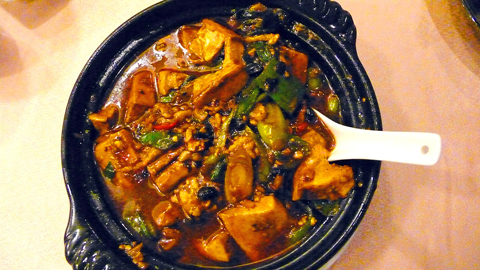Just about everyone who has been to a Chinese restaurant in North America has heard of General Tso’s chicken. But few people know the inventor of the sweet-and-sour deep-fried Hunan dish is Peng Chang-kuei (彭長貴), who opened Peng Yuan in Taipei in 1980 after running a successful restaurant business frequented by celebrities like Henry Kissinger in New York City during the 1970s.
According to the restaurant’s Web site, Peng was a favorite pupil of famed early 20th-century Chinese chef Cao Jing-chen (曹藎臣). After fleeing with Chiang Kai-shek’s (蔣介石) forces to Taiwan, Peng took up the role as the chef for national banquets. It was during this period when the legendary culinary artist started inventing recipes by modifying traditional Hunan dishes, including that of General Tso’s chicken.
It is said that many of the Hunan dishes served at restaurants in Taiwan are adaptations of Peng’s recipes.

PHOTO: HO YI, TAIPEI TIMES
Now a restaurant empire with seven locations in Taiwan that is run by Peng’s eldest son, Peng Yuan is where gourmands go to revisit the master’s oeuvre. This reviewer visited the flagship store on Linsen North Road, which has a second floor that can be used for wedding banquets and a third floor that is partitioned into rooms which seat around six tables of diners.
Renamed chicken a la viceroy (左宗棠雞, NT$280), Peng’s General Tso’s chicken is by no means the sweet variation usually found at Chinese restaurants in the US. Seasoned with chili and soy sauce, the dish doesn’t go overboard in spicing up the boneless chicken drumstick meat, which is tender on the inside and crispy on the outside.
Peng is also credited with inventing what has now become another culinary classic — fu kuei shuang fang (富貴雙方, NT$90 per tiny slice). Think of the dish as a Chinese sandwich filled with roasted bean curd slices (烤素方) and Chinese honey-glazed ham. The ham has just the right amount of fat to give the dish a juicy taste without seeming greasy, while the roasted bean curd is crunchy. Each bite is an explosion of tastes and textures.
Unlike fu kuei shuang fang, which was concocted for national banquets, Peng’s bean curd (彭家豆腐, NT$240) is a meal that the master created for his own lunch. Stewed with fermented soybeans, garlic and pork, the simple dish eloquently exemplifies the typical Hunan taste that is salty and spicy.
Other Hunan specialties include minced shrimp with lettuce (生菜蝦鬆, NT$480), shredded lamb tripe with yellow leeks (韭黃羊肚絲, NT$360) and the steamed assorted preserved meats (蒸腊味合, NT$480), a generous plate of preserved pork, fish and duck.
— HO YI

The Lee (李) family migrated to Taiwan in trickles many decades ago. Born in Myanmar, they are ethnically Chinese and their first language is Yunnanese, from China’s Yunnan Province. Today, they run a cozy little restaurant in Taipei’s student stomping ground, near National Taiwan University (NTU), serving up a daily pre-selected menu that pays homage to their blended Yunnan-Burmese heritage, where lemongrass and curry leaves sit beside century egg and pickled woodear mushrooms. Wu Yun (巫雲) is more akin to a family home that has set up tables and chairs and welcomed strangers to cozy up and share a meal

Dec. 8 to Dec. 14 Chang-Lee Te-ho (張李德和) had her father’s words etched into stone as her personal motto: “Even as a woman, you should master at least one art.” She went on to excel in seven — classical poetry, lyrical poetry, calligraphy, painting, music, chess and embroidery — and was also a respected educator, charity organizer and provincial assemblywoman. Among her many monikers was “Poetry Mother” (詩媽). While her father Lee Chao-yuan’s (李昭元) phrasing reflected the social norms of the 1890s, it was relatively progressive for the time. He personally taught Chang-Lee the Chinese classics until she entered public

Last week writer Wei Lingling (魏玲靈) unloaded a remarkably conventional pro-China column in the Wall Street Journal (“From Bush’s Rebuke to Trump’s Whisper: Navigating a Geopolitical Flashpoint,” Dec 2, 2025). Wei alleged that in a phone call, US President Donald Trump advised Japanese Prime Minister Sanae Takaichi not to provoke the People’s Republic of China (PRC) over Taiwan. Wei’s claim was categorically denied by Japanese government sources. Trump’s call to Takaichi, Wei said, was just like the moment in 2003 when former US president George Bush stood next to former Chinese premier Wen Jia-bao (溫家寶) and criticized former president Chen

President William Lai (賴清德) has proposed a NT$1.25 trillion (US$40 billion) special eight-year budget that intends to bolster Taiwan’s national defense, with a “T-Dome” plan to create “an unassailable Taiwan, safeguarded by innovation and technology” as its centerpiece. This is an interesting test for the Chinese Nationalist Party (KMT), and how they handle it will likely provide some answers as to where the party currently stands. Naturally, the Lai administration and his Democratic Progressive Party (DPP) are for it, as are the Americans. The Chinese Communist Party (CCP) is not. The interests and agendas of those three are clear, but